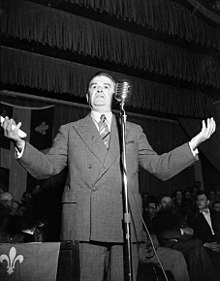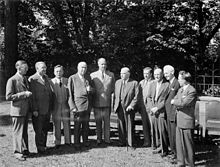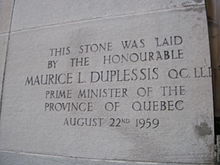Maurice Duplessis
Maurice Duplessis | |
|---|---|
 Duplessis campaigning in the 1952 election. | |
| 16th Premier of Quebec | |
| In office August 17, 1936 – November 8, 1939 | |
| Monarchs | Edward VIII George VI |
| Lieutenant Governor | Ésioff-Léon Patenaude |
| Preceded by | Adélard Godbout |
| Succeeded by | Adélard Godbout |
| In office August 30, 1944 – September 7, 1959 | |
| Monarchs | George VI Elizabeth II |
| Lieutenant Governor | Eugène Fiset Gaspard Fauteux Onésime Gagnon |
| Preceded by | Adélard Godbout |
| Succeeded by | Paul Sauvé |
| MNA for Trois-Rivières | |
| In office February 5, 1923 – September 7, 1959 | |
| Preceded by | Louis-Philippe Mercier |
| Succeeded by | Yves Gabias |
| Personal details | |
| Born | Maurice Duplessis April 20, 1890 Trois-Rivières, Quebec |
| Died | September 7, 1959 (aged 69) Schefferville, Quebec |
| Political party | Union Nationale |
| Other political affiliations | Conservative Party of Quebec(pre 1936) |
| Profession | Lawyer |
Maurice Le Noblet Duplessis (French pronunciation: [dzyplɛsi]; 20 April 1890 – 7 September 1959) served as the 16th Premier of the Canadian province of Quebec from 1936 to 1939 and 1944 to 1959. He rose to power after uniting his Conservative party and the breakaway Action liberale nationale progressive faction of the Liberal party of Premier Louis-Alexandre Taschereau, to form a new conservative party, the Union Nationale.[1]
His era later became known as La Grande Noirceur ("The Great Darkness") by separatist thinkers. During the time, the Liberal opposition was unsuccessful in challenging Duplessis' power. Duplessis championed rural areas, provincial rights and anti-Communism, and opposed the trade unions.
Early life
Duplessis was born in Trois-Rivières, the son of Berthe (née Genest) and local politician Nérée Le Noblet Duplessis. He studied at the Séminaire Saint-Joseph de Trois-Rivières, obtained a law degree from Université Laval's Montréal branch (later renamed Université de Montréal) and was admitted to the Barreau du Quebec in 1913. He returned to his home town to practice law until running for public office. He was a life-long bachelor.[2]
Political career


Duplessis first won the seat as a Conservative Party of Quebec candidate in the 1927 Quebec election. In the 1931 election, he was reelected in his seat, but Conservative leader Camillien Houde lost both the election and his own seat. The Conservative caucus chose C. E. Gault to be interim Leader of the Opposition but, after Houde resigned as party leader in 1932, Duplessis won the leadership of the party during the 1933 convention over the only other candidate, Onésime Gagnon.
Two weeks before the 1935 provincial election, he engineered a coalition with Paul Gouin's Action libérale nationale (ALN), a party of dissident reform Liberals and nationalists who had quit the governing Parti libéral du Québec. While he lost that election, Duplessis was soon able to exploit a patronage scandal involving the family of Premier Louis-Alexandre Taschereau to force Taschereau's resignation.
Gouin withdrew his support from Duplessis on June 18, 1936, but the ALN caucus sided with Duplessis and joined with his Conservative caucus to formally merge into the Union Nationale party. Duplessis and the UN won the August 1936 election in a landslide, putting an end to thirty-nine consecutive years of Liberal rule. Duplessis's first government was defeated in the 1939 election, a snap election called by the premier in hopes of exploiting the issue of Canadian participation in World War II.

Duplessis returned as premier in the 1944 election, and held power without serious opposition for the next fifteen years, until his death, winning elections in 1948, 1952 and 1956. He became known simply as le Chef ("the boss").
He was elected to five terms of office in all, the last four of them consecutive. Duplessis remains the last Quebec premier to have won three or more consecutive majority governments. After him, no political party in Quebec elections at the provincial level had managed to win more than two terms of office in a row until the December 2008 victory of Jean Charest's Liberal party, its third consecutive win.
Policies
Duplessis favoured rural areas over city development and introduced various agricultural credits during his first term. He was also noted for meagre investment in social services. Duplessis also opposed military conscription and Canadian involvement in World War II. The Union Nationale often had the active support of the Roman Catholic Church in its political campaigns and employed the slogan Le ciel est bleu; l'enfer est rouge: Heaven is blue (UN); Hell is red (Liberal).[3] "The persecution of the religious sect known as Jehovah’s Witnesses, now going on in Quebec Province with enthusiastic official and judicial sanction, has taken a turn which suggests that the Inquisition has returned to French Canada."—Toronto Globe & Mail, December 19, 1946.
Roncarelli v. Duplessis
Duplessis actively opposed Jehovah's Witnesses and once used his influence to revoke a liquor licence from one of their members' businesses. In Roncarelli v. Duplessis, the decision was overturned by the Supreme Court of Canada, Duplessis being ordered to pay $33,123.53 in damages.
Death and legacy

Duplessis died in office after a series of strokes he suffered while visiting the Iron Ore Company of Canada in Schefferville in the presence of seven government and company officials on September 7, 1959. Following his death and the subsequent election of a Liberal government under Jean Lesage in 1960, Quebec entered a period later termed the Quiet Revolution (Révolution tranquille), a decisive movement away from the conservative policies of Duplessis and toward a secular social democracy.
Duplessis has not been without his loyal defenders. Conrad Black's 1977 encomium, Duplessis, painted a sympathetic portrait of the man as a transitional figure towards modernism, and the victim of partisan attack and personal malady (Black revealed, for instance, that Duplessis suffered from hypospadias).[4]
Nevertheless, Duplessis's legacy has been the subject of repeated criticism in the decades since his death. Quebec nationalists dislike his anti-separatist stance, liberals denounce his social conservatism. Some minorities resent the privileges he granted to the Catholic church as other religious groups were actively or passively discouraged [citation needed] His critics hold that Duplessis's inherently corrupt patronage politics, his reactionary conservatism, his emphasis on traditional family and religious values, his anachronistic anti-union stance, rural focus and his preservation and promotion of Catholic Church institutions over the development of a secular social infrastructure akin to that underway in most of the postwar West, stunted Quebec's social and economic development by at least a decade.
In response, it has been argued that the notion of the Duplessis "black years" is a myth propagated by all subsequent major political actors in Quebec due to a fundamental aversion to Catholic church-oriented traditionalist patterns of development, with dominant intellectual movements combining various elements of this dislike. However, the counter-argument, that this is an over-simplification which fails to capture the complexities of Quebec politics, society and its economy, has consistently prevailed in public and academic discourse for some time.
Aside from occasional defenders of his anti-Communist and socially conservative views,[5][6] defence of the Duplessis regime today comes primarily from traditionalist conservatives (paleoconservatives in North American definition) who view his regime as an essential reaffirmation of traditional values, and as an assertion by democratic means of the basics of church and family life with low social spending and suppression of labour unions.[citation needed] Duplessis is thereby held to have prevented "subversion" without the massive use of force and police repression that characterized the dictatorial policies of the Franco regime in Spain (which he supported).[citation needed]
The Canadian Historical Association in a booklet on file with Collections Canada puts it this way:
- "The Duplessis regime may well have endured for too long, the Union Nationale leader's traditionalist policies may well have been anachronistic when compared with the relatively modern society that, in many respects, the Quebec of the 1950s had already become.[7]"
For better or worse, Duplessis lent stability to Quebec through turbulent times.[citation needed] For this he is praised by some[by whom?] and reviled by many[by whom?]. Few Quebecois view him favourably in public discourse today, but he devoted much of his life to public office and was sufficiently popular with the Quebec electorate of the period to spend almost two decades as Premier, a position he held until his death. Duplessis' defenders[who?] also note that political patronage under his government did not differ very much from a similar patronage system under Taschereau's Liberals in earlier decades.[citation needed] Furthermore, there is no evidence that Duplessis ever personally enriched himself, as he died in debt.[clarification needed]
Ironically, it could be argued[by whom?] that Duplessis' greatest legacy was to lend impetus, after his death, to the societal changes he opposed throughout his political life.[citation needed] That his suppression of modernizing elements in Quebec produced a sense of urgency among the non-traditional populace and political elites[clarification needed] which amplified the speed and scope of the social, political and economic transformation of Quebec under subsequent governments. In short, that the failure of the Duplessis regime to accommodate the demands of an increasingly cosmopolitan populace acted as both trigger and catalyst for the Quiet Revolution.[citation needed]
See also
- Politics of Quebec
- Prime Minister nicknaming in Quebec
- Timeline of Quebec history
- Padlock Law
- Duplessis Orphans
References
- ^ Black, Conrad M. (2011). "Duplessis, Maurice Le Noblet". The Canadian Encyclopedia, Historica Foundation, Toronto. Retrieved January 31, 2011.
- ^ MICHEL SARRA-BOURNET (2009). "DUPLESSIS, MAURICE LE NOBLET". University of Toronto/Université Laval. Retrieved October 3, 2013.
{{cite web}}: CS1 maint: numeric names: authors list (link) - ^ Verna, Gérard (2006). "Le fait religieux au Canada" (in French). Université Laval. Retrieved July 7, 2011.
- ^ Conrad Black, Duplessis, (McLelland & Stewart, 1977)
- ^ Côté, Pauline (2004). "Public Management of Religious Diversity in Canada". In Richardson, James T. (ed.). Regulating religion: case studies from around the globe legacy. Springer. p. 425. ISBN 9780306478864.
- ^ Frost, Catherine (2006). Morality and nationalism. Taylor & Francis. p. 157. ISBN 9780203086179.
- ^ Jones, Richard (1983). Duplessis and the Union National [sic] Administration (PDF). The Canadian Historical Association. p. 17.
Sources
- Conrad Black, Duplessis, ISBN 0-7710-1530-5, McClelland & Stewart, Toronto, 1977.
- CSN-CSQ, Histoire du mouvement ouvrier au Quebec, 2001
- Jones, R. (1983). Duplessis and the Union Nationale Administration. Ottawa: Canadian Historical Association.
- Laporte, P. (1960). The True Face of duplessis. Montreal: Harvest House Limited.
- Paulin, M. (2002). Maurice Duplessis: Powerbroker, Politician. Montreal: XYZ Publishing.
- Rouillard, Jacques. (2004). Le syndicalisme québécois, Boreal, Montreal
External links
- Biography of Maurice Duplessis
- "Biography". Dictionnaire des parlementaires du Québec de 1792 à nos jours (in French). National Assembly of Quebec.
- May 22 1999 Article On Duplessis
- CBC Digital Archives - Maurice Duplessis
*The Union Nationale was founded as an alliance in 1935 with Duplessis as leader. In 1936 the UN formally became a unitary political party with the Quebec Conservative Party dissolving into it.
- 1890 births
- 1959 deaths
- Canadian anti-communists
- Canadian political party founders
- Canadian Roman Catholics
- Conservatism in Canada
- Conservative Party of Quebec MNAs
- Lawyers in Quebec
- People from Trois-Rivières
- Persons of National Historic Significance (Canada)
- Premiers of Quebec
- Leaders of the Union Nationale (Quebec)
- Union Nationale (Quebec) MNAs
- Université de Montréal alumni
